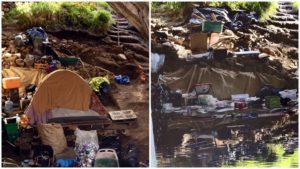As heavy rains battered San Jose early Thursday, city officials mobilized an emergency response team to warn residents along the Guadalupe River to evacuate from flash floods, but some homeless residents camping at Roosevelt Park along Coyote Creek say they were left behind.
Many of those unhoused individuals — some of whom lost everything during a flooding disaster in 2017 — decided to pack up their things and flee uphill, away from rising currents.
But they didn’t go far. Those camping at Roosevelt Park couldn’t access a safe, indoor warming center just a few yards away during the height of the storm Thursday.
That’s because the city’s overnight warming centers for inclement weather won’t be open until Friday night. City officials said it takes 48 hours to get the three warming stations up and running, though many centers across the county opened earlier this week. San Jose’s overnight centers, located at the Bascom Community Center, Leininger Community Center and Roosevelt Community Center, are activated by the city when temperatures drop below 40 degrees overnight.
But the area’s homeless residents aren’t waiting for the city centers to open. They’ve already begun fleeing their encampments to avoid getting swept by the rising waters.
“I’m not going to risk losing all of my stuff,” said 37-year-old Pancho Carrillo, who has lived in Roosevelt Park for about eight months. “So the best thing is just to move up before the next real rain comes.”


Carrillo, along with more than a dozen homeless residents in the park, have been moving uphill away from Coyote Creek since heavier rains started creeping into the city over the last several weeks. Many have lost belongings to the flowing water, caught off-guard by a rising current overnight.
Carrillo moved everything he owns to higher ground last week.
This week’s rainwater was not enough to flood the entire park, but campers are concerned the flood might come soon.
“They say when it comes, it comes,” Carrillo said.
San Jose officials are taking extra precautions this winter to warn residents in flood zones, activating the emergency operations center, going door to door and blasting out multi-language alerts. It’s a concerted effort to avoid the missteps of two years ago when the city failed to alert residents of the approaching flood until it was too late. More than 14,000 Rock Springs and Olinder Park residents were displaced by the February 2017 disaster that caused $100 million in property damage.
The area’s homeless residents were among those hit hardest.
Jennifer, a 38-year-old Roosevelt Park homeless resident who only provided her first name, lost her camp to Coyote Creek’s waters two weeks ago. She was camped next to the water when heavy rains after midnight swarmed her tent.
“This is my only tent,” she said. “I had to get it out.”
She grabbed what she could but that didn’t stop the water from ruining some of her belongings — an electric air mattress, clothes and the carpet that blanketed her campsite. She’s lived in the park for about three years.
“I miss how we had our spot out here. It was cute,” she said. “You can’t even picture it now.”
And she’s seen the area flood before.
“I was here in 2017,” she said. That year, the low parts of the park filled up like a basin with flood water from the creek. “All you could see was the top of the light post.”
And though she, Carrillo and the other homeless residents of Roosevelt Park live within a few yards of a city-operated overnight warming center, they cannot access the Roosevelt Center until it opens on Friday. The city’s website says the centers open during “persistent rainfall forecasted for two or more days,” but the Roosevelt Center’s doors have been closed during the area’s most recent storms.
HomeFirst CEO Andrea Urton told San José Spotlight that it’s not easy staffing the warming centers in San Jose.
“It’s always a challenge because we’re looking at people who currently have full-time jobs and we’re asking them to pull additional shifts in the evening,” Urton said. “It’s a graveyard shift, it’s hard.”
By Thursday morning, San Jose officials tweeted that the city demobilized its emergency operations center.
“Creek levels are going down,” the tweet said. “Residents should stay alert and continue to follow city channels, social media and website.”
Meanwhile, warming centers across the county, including Gilroy and Sunnyvale, opened their doors earlier in the week. Urton said homeless residents were allowed to stay inside all day.
For a full list of warming centers countywide, click here.
Contact Kyle Martin at [email protected] or follow him @Kyle_Martin35 on Twitter.



Leave a Reply
You must be logged in to post a comment.